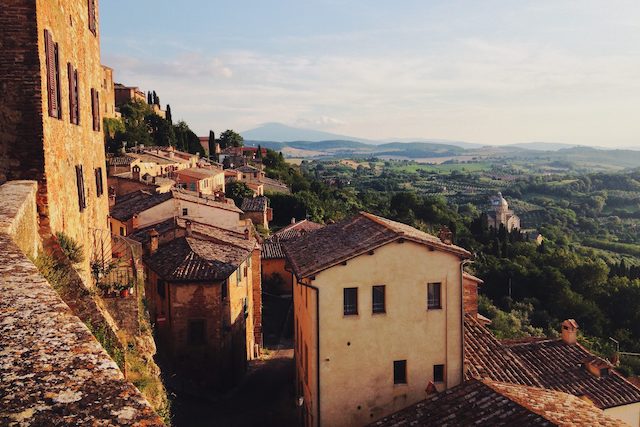The New Decameron Amid Italy’s Red Zone

In 1348 the Black Death struck Florence. It was one of the most appalling calamities that ever befell Europe. Three out of four in the city died. Those who were able fled to the hills, convinced that the end of the world had come.
One of the survivors of the plague was Giovanni Boccaccio, and his memories of the catastrophe provided the background for the classic work of Italian literature, The Decameron.
It was against a setting of horror and pestilence that he presented his immortal stories, told through the lens of ten refugees from Florence (seven ladies and three young men), who had fled to the seclusion of a great villa on the slopes of Fiesole. There, they whiled away with story-telling what little of life seemed to remain for them.
The Decameron has stood the test of centuries and remains one of the greatest books in all literature. It covers the vast panorama of 14th-century Italian life with an infinite variety of character, but it is not of a single age. The tales have the perennial freshness of unchanging human nature, for Boccaccio had an extraordinary comprehension of mankind, and he was not unsympathetic. He too was ‘born with the gift of laughter and a sense that the world was mad.’
The people in his pages still live, and their robust vitality has given The Decameron its real immortality. It is as true to life, all life, as any book ever written, and some knowledge of its contents is a prime requisite of a liberal education.
Italians would soon find themselves in the middle of a complete shutdown of the beloved country ~ La bella Italia.
Fast forward to modern-day Italy of 2020 and we find ourselves in the ironic position of being on the precipice of literary superfluity. A new Decameron was on the horizon. From February 22, when the first date on the Coronavirus curve was placed, and then in just a few days with the exponential doubling of Covid-19 cases and fatalities in Italy initially reported, stories steadily unfolded.
First, there were the social memes. ‘L’amuchina geniale’ was an early front runner. The hotly followed television series of Elena Ferrante’s My Brilliant Friend had just aired in Italy on RaiUno, with her second novel in the series, The Story of a New Name. The meme shows Lila and Lenù as young women, their faces covered in light blue hospital masks, holding bottles of Amuchina, Italy’s nationally recognized red-and-white-labeled, hospital-strength disinfectant.
We grimaced and shared it. Because as of that meme’s first appearance, there were still no cases reported in Napoli, where Lila and Lenù in the novel live. Nor in the region of Campania for maybe more than a week to come. Campania was still a non-existent line on the curve.
Yet with little time to spare, Italians would soon find themselves in the middle of a complete shutdown of the beloved country ~ La bella Italia.
In my hilltop village in the far eastern confines of Campania, called Alta Irpinia, life seemed to continue as normal. Fresh fruit and vegetable markets opened weekly, and stores and shops were running business as usual. The passeggiata was still an early evening men’s social stroll before retiring for dinner, and young adults continued to gather for their nightlife.
But I began to see an array of images and videos on my Twitter feed that seemed out of a new reality. A parish priest in an open-back Ape car, with a statue of the Madonna and a microphone, blessing neighborhood palazzo’s from the street. Announcements from carabinieri by electric megaphone seen from balconies, red emergency lights glaring, circling empty neighborhoods below.
But it was still the north. These new habits and alarms had not yet reached our southern regional communities. Apart from all the news now pouring out of China, the northern region of Lombardy where patient zero had presumably entered, and other hot spot cities of the north; Southern Italy as a whole seemed unaffected.
Then within a very short time, things got very serious. The northern regional Red Zones under tremendous stress were isolated. The wolf was at the door.
The rest of Italy was, in effect, blindsided.
On the evening of March 5th, the announcement came that all schools across Italy, not just the north, would close until March 15. All soccer and sports matches were cancelled until further notice. And first suggestions that the elderly, the weakest of those who may contract the virus, were to remain in their homes. The most surprising (if not the most difficult of all): a ban on the ubiquitous Italian greeting of the double kiss. Hard to believe that these early and fairly strict precautions would be only a precursor for the things quickly to come.
We all tried to stay calm and just go about our daily lives. I went to the vegetable market, bought fresh ground coffee and local cheeses at my favorite shops. All seemed a little tense but otherwise manageable. Friends still gathered. Extended family’s had their meals together as they’d always done.
When Presidente del Consiglio, Giuseppe Conte, took to RAI TV Italia’s public service broadcast network backed by the strong support of The World Health Organization to declare, on March 9th, one day after International Women’s Day, a Red Zone for the entire country, a new global precedent was born.
‘Our habits therefore must change. They must change now. For the good of Italy.’
That night I sent out one tweet.
‘It’s Sunday. Full moon #LockdownItalia. March 9th, 2020.’
He doubled down just two days later.
On Tuesday March 11th Giuseppe Conte delivered his second national address, effectively closing down the entire country.
‘In this moment everyone is watching,’ Conte said. ‘The solution is to stay at home. If we all comply with these rules, we will get out of it as soon as possible. Let’s stay away today, to hug each other warmer and run faster tomorrow.’
Io resto a casa. I stay home. The hashtag to save Italian lives.
La Repubblica’s huge headline on Thursday March 12th confirmed; CHIUDE ITALIA. Italy closes.
Social media ignited with hashtags and hegemony. ‘La movida non c’e piu.’
Then the exodus began. Trains and busses carrying students and employees from the north, south.
The following day, announcements from carabinieri by electric megaphone circled our hilltop town of Calitri, population 3000, twice a day. Instructing how to contact medical personnel in the event of coronavirus symptoms and when, as they continued to stress all new and existing social distancing ordinances.
On my balcony with the beautiful view, narcissus, freesia and early roses in pots are blooming and the temperature has seen 68° these last two days. Gorgeous, sunny early spring weather in the Southern Apennines, even in Italy’s Red Zone.
#ItaliaZonaRossa effectively vanquished the Italian way of life in general and many other social habits specifically for Italians all over the country. I soon found myself describing a dystopian Italian Red Zone of silence and inactivity to friends and family back in the USA, in what everyone knows is the most socially dependent nation on earth. As we all stayed home.
With March 9th’s announcement, I pulled out my copy of Giovanni Boccaccio’s The Decameron. Apropos of, well, everything, it seemed a kind of circle game and a great reread (as a kind of sanity booster) for the new COVID19-Italia. Where everyone and everything was now effectively on total lockdown. The Decameron was one of many Italian themed novels, books and volumes I found on a free book cart in Los Angeles, years ago. It became my Italian literary education, and not only.
This private illustrated edition with its vintage title page was published in 1930 by the Garden City Publishing Company. I had forgotten about that. My American hometown, the village of Stewart Manor, was incorporated in 1927 to Garden City, New York.
There’s a saying here: ‘Fatti vedere,‘ let me see you. An affectionate appeal to someone you’re fond of to come around more often. Stay visible. Even in rural Eastern Campania small-town streets normally filled with passeggiatori to see and be seen, quickly thinned out. Alone up here on the hilltop, we went out for essentials only. Until we could not go out anymore.
To feel connected, I began to tweet the opening salvos of each new day in The Decameron. ‘Here begins the book called The Decameron,’ Boccaccio writes in 1348, ‘one hundred tales, told in ten days by seven ladies and three young men.’ I added updated Coronavirus news that oddly mirrored the stories themselves, and the hashtag #Decameron2020 took care of itself.
Enter Flashmob Sonoro, the viral phenomenon where homebound Italians took to their balconies and windows with their instruments and voices in a nationwide call to solidarity and humanity, singing and playing to heal themselves and their countrymen. And the hashtags #Italianonmolla and #ItaliaStrong were born.
But the stringencies and coronavirus cases continued to mount. An overwhelmed medical system up north was giving way. The country’s curve had yet to peak, and the southern regions were bracing for impact. The President again tightened restrictions. Fines were imposed for not heeding the stay-at-home directive for all non-essential activity.
Siamo tutti a casa, c’e un silencio enorme, ma dobbiamo #StateACasa! And we remained at home.
Extended families no longer had lunches together. In this agricultural region, those with land to tend barely visited it. Nevertheless, there is an alimentari, or small grocery store, open just down my street, a forno for fresh bread not far from there. From my neighbor and via Fontana fixer I get fresh country eggs, six to a dozen at a time. She is my local olive oil source too. Tomato sauce is never wanting. When I’m in, she sends me home with wild greens and other seasonal vegetables at hand from her upcountry farm.
‘Andrà tutto bene.’ We are living through history. Everything will be fine.
I’m about to sit down to a home-cooked lunch, the main meal of an Italian’s day. Something I do nearly seven days a week. On my balcony with the beautiful view, narcissus, freesia and early roses in pots are blooming and the temperature has seen 68° these last two days. Gorgeous, sunny early spring weather in the Southern Apennines.
Children home from school all over Italy have created their own flash mob event, painting banners with brightly colored rainbows and white fluffy clouds on either end to hang over their balconies and post to FB with the salvo, ‘andrà tutto bene.’
We are living through history.
Everything will be fine.









Talk about living through history! Great piece. Hope all is well over there.
Poignant essay on life as it’s being lived currently in Italy under the seige of COVID-19. Thank you Angela!
Congratulazioni!You are an excellent writer, your article is full of emotions